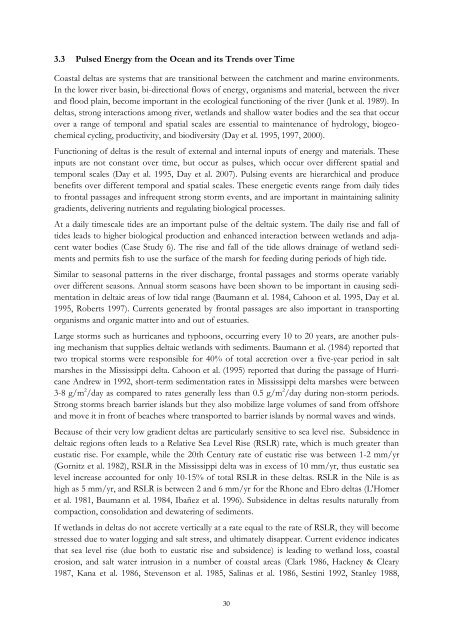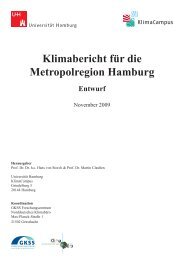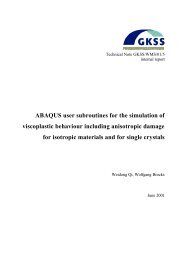Dynamics and Vulnerability of Delta Systems - loicz
Dynamics and Vulnerability of Delta Systems - loicz
Dynamics and Vulnerability of Delta Systems - loicz
Create successful ePaper yourself
Turn your PDF publications into a flip-book with our unique Google optimized e-Paper software.
3.3 Pulsed Energy from the Ocean <strong>and</strong> its Trends over Time<br />
Coastal deltas are systems that are transitional between the catchment <strong>and</strong> marine environments.<br />
In the lower river basin, bi-directional flows <strong>of</strong> energy, organisms <strong>and</strong> material, between the river<br />
<strong>and</strong> flood plain, become important in the ecological functioning <strong>of</strong> the river (Junk et al. 1989). In<br />
deltas, strong interactions among river, wetl<strong>and</strong>s <strong>and</strong> shallow water bodies <strong>and</strong> the sea that occur<br />
over a range <strong>of</strong> temporal <strong>and</strong> spatial scales are essential to maintenance <strong>of</strong> hydrology, biogeochemical<br />
cycling, productivity, <strong>and</strong> biodiversity (Day et al. 1995, 1997, 2000).<br />
Functioning <strong>of</strong> deltas is the result <strong>of</strong> external <strong>and</strong> internal inputs <strong>of</strong> energy <strong>and</strong> materials. These<br />
inputs are not constant over time, but occur as pulses, which occur over different spatial <strong>and</strong><br />
temporal scales (Day et al. 1995, Day et al. 2007). Pulsing events are hierarchical <strong>and</strong> produce<br />
benefits over different temporal <strong>and</strong> spatial scales. These energetic events range from daily tides<br />
to frontal passages <strong>and</strong> infrequent strong storm events, <strong>and</strong> are important in maintaining salinity<br />
gradients, delivering nutrients <strong>and</strong> regulating biological processes.<br />
At a daily timescale tides are an important pulse <strong>of</strong> the deltaic system. The daily rise <strong>and</strong> fall <strong>of</strong><br />
tides leads to higher biological production <strong>and</strong> enhanced interaction between wetl<strong>and</strong>s <strong>and</strong> adjacent<br />
water bodies (Case Study 6). The rise <strong>and</strong> fall <strong>of</strong> the tide allows drainage <strong>of</strong> wetl<strong>and</strong> sediments<br />
<strong>and</strong> permits fish to use the surface <strong>of</strong> the marsh for feeding during periods <strong>of</strong> high tide.<br />
Similar to seasonal patterns in the river discharge, frontal passages <strong>and</strong> storms operate variably<br />
over different seasons. Annual storm seasons have been shown to be important in causing sedimentation<br />
in deltaic areas <strong>of</strong> low tidal range (Baumann et al. 1984, Cahoon et al. 1995, Day et al.<br />
1995, Roberts 1997). Currents generated by frontal passages are also important in transporting<br />
organisms <strong>and</strong> organic matter into <strong>and</strong> out <strong>of</strong> estuaries.<br />
Large storms such as hurricanes <strong>and</strong> typhoons, occurring every 10 to 20 years, are another pulsing<br />
mechanism that supplies deltaic wetl<strong>and</strong>s with sediments. Baumann et al. (1984) reported that<br />
two tropical storms were responsible for 40% <strong>of</strong> total accretion over a five-year period in salt<br />
marshes in the Mississippi delta. Cahoon et al. (1995) reported that during the passage <strong>of</strong> Hurricane<br />
Andrew in 1992, short-term sedimentation rates in Mississippi delta marshes were between<br />
3-8 g/m 2 /day as compared to rates generally less than 0.5 g/m 2 /day during non-storm periods.<br />
Strong storms breach barrier isl<strong>and</strong>s but they also mobilize large volumes <strong>of</strong> s<strong>and</strong> from <strong>of</strong>fshore<br />
<strong>and</strong> move it in front <strong>of</strong> beaches where transported to barrier isl<strong>and</strong>s by normal waves <strong>and</strong> winds.<br />
Because <strong>of</strong> their very low gradient deltas are particularly sensitive to sea level rise. Subsidence in<br />
deltaic regions <strong>of</strong>ten leads to a Relative Sea Level Rise (RSLR) rate, which is much greater than<br />
eustatic rise. For example, while the 20th Century rate <strong>of</strong> eustatic rise was between 1-2 mm/yr<br />
(Gornitz et al. 1982), RSLR in the Mississippi delta was in excess <strong>of</strong> 10 mm/yr, thus eustatic sea<br />
level increase accounted for only 10-15% <strong>of</strong> total RSLR in these deltas. RSLR in the Nile is as<br />
high as 5 mm/yr, <strong>and</strong> RSLR is between 2 <strong>and</strong> 6 mm/yr for the Rhone <strong>and</strong> Ebro deltas (L'Homer<br />
et al. 1981, Baumann et al. 1984, Ibañez et al. 1996). Subsidence in deltas results naturally from<br />
compaction, consolidation <strong>and</strong> dewatering <strong>of</strong> sediments.<br />
If wetl<strong>and</strong>s in deltas do not accrete vertically at a rate equal to the rate <strong>of</strong> RSLR, they will become<br />
stressed due to water logging <strong>and</strong> salt stress, <strong>and</strong> ultimately disappear. Current evidence indicates<br />
that sea level rise (due both to eustatic rise <strong>and</strong> subsidence) is leading to wetl<strong>and</strong> loss, coastal<br />
erosion, <strong>and</strong> salt water intrusion in a number <strong>of</strong> coastal areas (Clark 1986, Hackney & Cleary<br />
1987, Kana et al. 1986, Stevenson et al. 1985, Salinas et al. 1986, Sestini 1992, Stanley 1988,<br />
30





